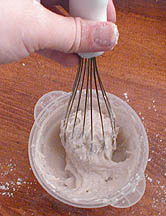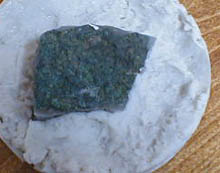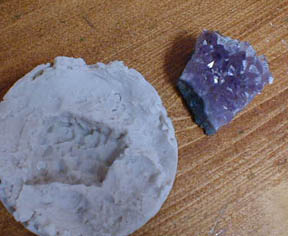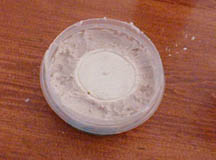

Home / Sculpting / Making a Mold / Casting / Painting / Gem Making Tutorial / Links / Contact Me


It was a few days before I had worked up the courage to experiment with Instamold again. (I wasn't quite yet ready to write it off as useless, when its failures could have readily been attributable to human error, namely mine.) So I measured it out and mixed it exactly as the instructions had specified, adding a little bit of Instamold powder to the water at a time and mixing it thoroughly with a wire whisk before adding more powder.

I mixed until the compound began to solidify (going past cake-batter thickness and into the realm of blueberry-muffin batter thickness.) I squeezed the compound out of the whisk and spooned it into a shallow tupperware dish, making sure the surface was nice and even before I proceeded to the next step.

Instead of risking my wolf ornament sculpture and gumming it up, I chose this time to risk a chunk of amethyst rock I had sitting on a shelf. It had various facets and dimples, (although nothing too complicated, so I felt there was little danger of it getting stuck in the mixture.)

After a few minutes, I lifted it and, well, whaddaya know? It worked. The mold hardened to a rubbery thickness and the surface of the rock was faithfully recreated. Perhaps this stuff wasn't useless after all. (I just needed to exercise a little more care when mixing it...)

And so I felt it was safe to move onto the next step: using Instamold to cast my wolf ornament. I mixed up a batch the new and careful way and pressed my sculpture into it. Unfortunately, I can't show you the result, because I...well... I accidentally forgot to take a "finished" picture before tossing the mold. (I can describe what happened, though - The wolf ornament was molded almost perfectly - except for the area around the mouth, which was all crumbly. I figured it was because the mouth area had an overhanging "lip" which marred the side of the mold as it was being removed.) FINAL VERDICT: Instamold does work as advertised for creating molds of small, simple sculpted objects. However, if the object has any parts that overhang others or undercuts, then you're better off using a stretchier molding compound like latex.
NOTE: Instamold also has another potential use, as a filler for making a two-part mold. This page shows it in action.
Here's what happened when I tried to cast with Instamold...
